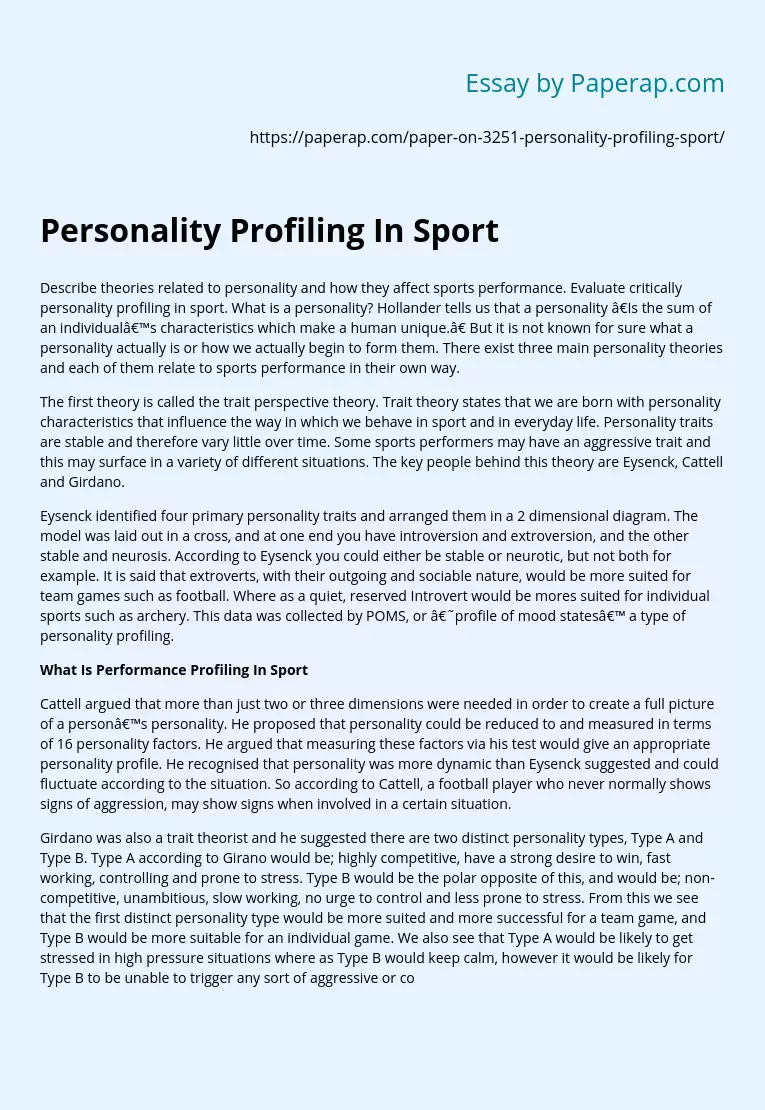Personality Profiling In Sport
Describe theories related to personality and how they affect sports performance. Evaluate critically personality profiling in sport. What is a personality? Hollander tells us that a personality ”Is the sum of an individual’s characteristics which make a human unique.” But it is not known for sure what a personality actually is or how we actually begin to form them. There exist three main personality theories and each of them relate to sports performance in their own way.
The first theory is called the trait perspective theory.
Trait theory states that we are born with personality characteristics that influence the way in which we behave in sport and in everyday life. Personality traits are stable and therefore vary little over time. Some sports performers may have an aggressive trait and this may surface in a variety of different situations. The key people behind this theory are Eysenck, Cattell and Girdano.
Eysenck identified four primary personality traits and arranged them in a 2 dimensional diagram.
The model was laid out in a cross, and at one end you have introversion and extroversion, and the other stable and neurosis. According to Eysenck you could either be stable or neurotic, but not both for example. It is said that extroverts, with their outgoing and sociable nature, would be more suited for team games such as football. Where as a quiet, reserved Introvert would be mores suited for individual sports such as archery. This data was collected by POMS, or ‘profile of mood states’ a type of personality profiling.
What Is Performance Profiling In Sport
Cattell argued that more than just two or three dimensions were needed in order to create a full picture of a person’s personality. He proposed that personality could be reduced to and measured in terms of 16 personality factors. He argued that measuring these factors via his test would give an appropriate personality profile. He recognised that personality was more dynamic than Eysenck suggested and could fluctuate according to the situation. So according to Cattell, a football player who never normally shows signs of aggression, may show signs when involved in a certain situation.
Girdano was also a trait theorist and he suggested there are two distinct personality types, Type A and Type B. Type A according to Girano would be; highly competitive, have a strong desire to win, fast working, controlling and prone to stress. Type B would be the polar opposite of this, and would be; non-competitive, unambitious, slow working, no urge to control and less prone to stress. From this we see that the first distinct personality type would be more suited and more successful for a team game, and Type B would be more suitable for an individual game. We also see that Type A would be likely to get stressed in high pressure situations where as Type B would keep calm, however it would be likely for Type B to be unable to trigger any sort of aggressive or competitive characteristic when it mattered.
The second theory is called the social learning perspective theory. The social learning theory, developed by Bandura, differs from trait and interactional approaches in that it sees individual differences in behaviour as resulting from different learning experiences. This means that what determines an individual’s response to a situation is not so much their genetic make-up or the constraints of the particular situation, but instead how past experience has taught that person to act. Behaviour therefore changes depending on the situation and is therefore a product of our interaction with the environment. Bandura’s model shows us how this personality theory affects sports performance. An inexperienced performer may be inspired by the positive attitude and commitment of an experienced player, and then chooses to copy desirable approach, receiving positive reinforcement in doing so.
The third and final personality theory is the interactionist approach, which was based on the work done by Hollander. It is a combination of the trait and social learning perspectives. It suggests to us that personality is modified and behaviour is formed when genetically inherited traits are triggered by an environmental circumstance, thus meaning that behaviour is unpredictable. It also explains to us why behaviour can change in different situations, so for example a competitive rugby player may not be so competitive when off the field of play.
Personality profiling is done to see which personalities are fit for what sport, and if a certain individual personality is one that all athletes may share. This is difficult due to the fact there is no clear, universal definition of a personality. Personality profiling involves measuring an athlete on a number of personality scales and building up a picture of their strengths and weaknesses. Tests can be measured in a various number of ways, through; questionnaires, interviews, observations or profile of mood states. There are a number of problems with personal profiling though.
There is no conclusive evidence that a sports personality actually exists, so far there only exists theories surrounding the matter and no hard evidence. Profiling results are usually subjective, and conclusions may be influenced by personal opinions with no support of scientific evidence. Profiling results are invalid more often than not. It is feared that an athlete may unconsciously modify their own behaviour to match up to the profile ascribed to them. There also exists a reliability issue, due to the fact questionnaires are often carried out using self report, so therefore not always answered correctly or honestly.
Personality Profiling In Sport. (2019, Dec 05). Retrieved from https://paperap.com/paper-on-3251-personality-profiling-sport/

